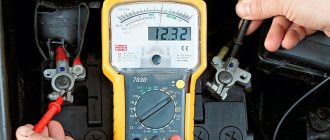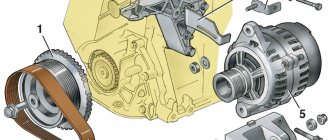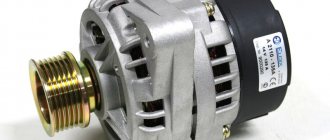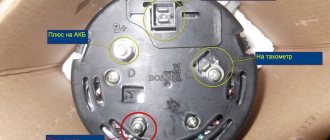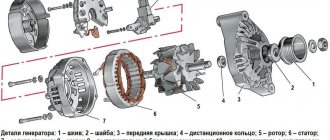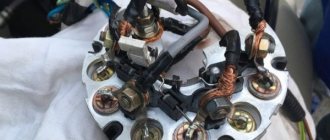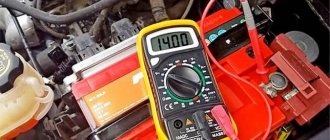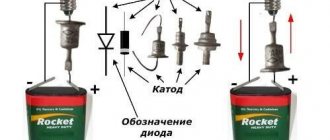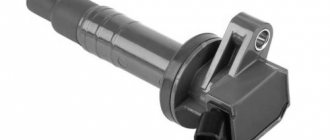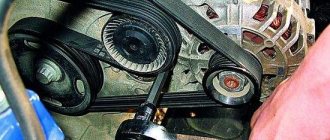Which cars are affected by the problem?
Naturally, the probability of the battery receiving an excess charge on new foreign cars is significantly lower than on products with a significant mileage from the domestic automobile industry.
However, there are a number of models where overcharging is considered a common problem. We are talking about classic VAZ cars. Among the “classics”, this malfunction most often occurs on the “six” (VAZ 2106).
Trucks and some UAZ models are equipped with on-board voltage sensors and sometimes these sensors begin to signal an increase in the charging current between the generator and the battery (18V or more). This is not normal and may lead to rapid overcharging. However, often the problem is in the sensors themselves, which show incorrect information.
Is it possible to charge a full battery?
Reasons for discharging the VAZ 2110 battery
Many car enthusiasts know the phenomenon of battery overcharging. It occurs when, for some reason, the voltage regulator starts to work incorrectly, so the voltage at the generator output exceeds 14.5 Volts. The optimal voltage of a fully charged battery is 14 Volts. When the voltage difference between the generator and the battery exceeds one volt, the latter begins to absorb additional energy, which leads to boiling and evaporation of the electrolyte, as well as destruction of the lead plates. As a result, the electrolyte level first decreases, then the battery capacity decreases. After a short time (depending on the generator voltage), the drop in capacity becomes irreversible and cannot be restored by adding distilled water.
If the generator voltage regulator is working normally, then the voltage is maintained at 14 - 14.5 Volts, due to which the battery avoids overcharging. All this fully applies to stationary battery charging, which is carried out using a special charger. If the voltage at the output of the device does not exceed 14.5 Volts, then the battery will take the amount of electricity that is necessary to change the density of the electrolyte. When the voltage of the generator and the charger are equal, the rate of absorption of electricity will drop so much that further charging becomes meaningless. Even if the battery sits on the charger for two days, its capacity and charge will not change. If the voltage at the charger output exceeds 14.5 - 15 Volts, then overcharging will begin, which will lead to a decrease in battery capacity.
If you are using a charger that displays charging current but not voltage, consider the following. The charging current of a fully charged battery should not exceed 1 percent of its capacity. As soon as the charging current has dropped to 1-2 percent, it is necessary to disconnect the battery from the charger to avoid damaging it. Do not charge the battery from a charger without a voltage indicator if the charging current is less than 5 percent of capacity. This will extend the life of the battery and protect it from premature damage.
What is battery recharging?
A working generator supplies no more than 14.5 volts to the battery, while a faulty one can raise the voltage in the on-board network to 25 volts , for this reason lamps and various kinds of sensors and devices can fail. At this voltage, the battery begins to get very hot and boil, which causes it to swell and possibly explode. Batteries removed from the vehicle and charged from a portable charger without supervision are not recommended.
A frequent breakdown of the generator is the failure of the relay regulator, which keeps the network voltage in the car within acceptable limits from 12.5 to 14.5 volts .
When starting the engine, the battery consumes energy by giving the accumulated electricity to the starter, after the engine starts, the generator is turned on by supplying it with a weak current to excite the electric brushes, then the accumulated electricity is restored in the battery by charging it from the generator.
Approximate battery voltage:
- While the engine is running, the average voltage should be 14.5 volts.
- In a quiet state (the engine is turned off), it is 12.5 volts.
- Recharging is considered when the voltage rises above 14.8 volts , respectively, with the engine running.
Car battery malfunctions
Pulse charger for car battery
The service life of a car battery depends on how it is used.
Here are some reasons why a car battery may die:
- battery plates are corroded
- the active coating of the battery plates has become depleted
- battery electrolyte is depleted
If the battery is poorly cared for, a number of malfunctions may also occur, for example the following:
- The battery plates will be coated with lead sulfate.
- The battery will self-discharge quickly.
- A short circuit will occur between the battery plates inside the battery.
- Electrolyte will leak out through cracks in the battery tank.
- The battery poles will oxidize.
Plate sulfation is the formation of a coating of large white lead sulfate crystals, also called sulfate, on battery plates.
Battery plates coated with sulfate cease to participate in the reactions occurring in the battery.
When sulfated plates appear in the battery, then the battery capacity decreases. The battery becomes unusable.
A characteristic sign that partial sulfation of the plates has occurred is the rapid discharge of the battery when the load is on.
The reasons causing sulfation of the plates are as follows:
- Systematic undercharging of the battery.
- The battery was stored in an incompletely charged state or with electrolyte not drained.
- The battery was charged below the permissible limit.
- The battery cells have low electrolyte levels.
- The electrolyte in the battery is of high density.
Any battery has natural self-discharge. Self-discharge occurs for various reasons.
For example, a lattice of plates and the active mass with which it is covered already constitute a galvanic couple and a local current also flows in it.
When the battery is in good condition, self-discharge does not exceed two percent per day of the battery capacity.
Self-discharge of the battery may increase if, when preparing the electrolyte, you use sulfuric acid or water contaminated with impurities (for example, undistilled water).
Additional vapors may also form in the battery when something foreign gets inside.
If the battery self-discharges due to dirty electrolyte, you need to drain it and wash the battery. And fill in a new good electrolyte.
Self-discharge of batteries increases due to high temperature, dirt, water and electrolyte on the lid, and so on.
Self-discharge of the battery can also occur from oxidized pins and terminals.
Oxidized battery terminals and pins must be cleaned.
During the operation of the battery in it, naturally gradually:
- Separators are destroyed.
- The active mass falls out of the plate grids.
- The reason that causes the active mass to fall out of the plates may be prolonged recharging of the battery, vibration, insufficient fastening of the plates, etc.
- As the charging current increases, the battery plates become warped.
The plates warp when there is a short circuit in the circuits, and if the electrolyte level has dropped, and when the starter is turned on for a long time and frequently - at this time the battery is loaded with a high discharge current.
Warping of the plates leads to their contact, that is, to a short circuit inside the battery itself and the operation of the battery stops.
Signs of a faulty voltage regulator
The engine and auto electrics must receive constant current. The stabilizer maintains the uniformity of the network voltage coming from the generator, preventing it from falling or rising too much. Initially, this unit was made electromagnetic, but the relay (regulator) of the new model received a completely electronic semiconductor design. Often it is this part that causes voltage surges and sags.
The generator produces low voltage
In the case of a low level, the cause may be a breakdown or excessive wear of the graphite brushes of the regulator. Sometimes the generator on the Priora produces low voltage due to short circuits and open circuits. All this leads to a small current or its disappearance. In such cases, the node needs to be diagnosed and, possibly, the device needs to be replaced.
Other signs:
- dim headlights;
- turning off on-board equipment, radio;
- Battery drains quickly, its charging is poor.
The machine can help the owner diagnose the low-voltage generator on the Priora using a battery test lamp. The network status is also displayed on the instrument panel.
Power surges
Signs of this are:
- fuse burnout;
- shaking of the voltmeter needle on the panel, if present;
- flashing headlights and interior lighting;
- “jerking” of the engine, including at idle.
The brush assembly can unnecessarily increase the power level in the network: many Lad Prior owners complain about this.
Other options include:
- poor contact;
- generator malfunction.
The general recommendation in this case is to check the regulator by measuring the voltage with a voltmeter at the battery terminals.
The generator does not produce current
If this situation occurs, the battery error indicator on the panel lights up.
If there is no charging at all, the wires may break or the diode bridge may malfunction. Sometimes there is no current when one of the fuses blows, for example, F4, F6. You can simply change them.
Among other reasons why the unit stops producing the proper current:
- critical wear of armature brushes or slip rings;
- general malfunction of the LV (voltage regulator);
- more unpleasant failures of bearings, stator, rotor, etc.
There are situations when there is actually voltage, but it is not displayed on the dashboard. This usually indicates a burnt-out light bulb in the panel.
What can constant overcharging lead to?
- During recharging, the electrolyte boils, and it partially flows out through the gas outlet holes and plugs of the cans. If the process continues long enough, the leaked sulfuric acid solution will end up on the radiator, wires, cooling hoses and body. The acid concentration is not high, but over time it will corrode some of the above.
- With a slight overcharge, the electrolyte falls on the battery case in the form of condensation on the terminals, causing them to oxidize and become covered with a green coating.
- Evaporation of the electrolyte leads to a decrease in its level in the banks, some of the electrodes are exposed, the plates overheat and the active mass falls off from them. This threatens to short circuit the cans and cause the battery to fail completely.
- Recharging at the final stage is accompanied by significant overheating, during which the electrolyte water breaks down into oxygen and hydrogen. The resulting mixture of gases may explode, with acid ending up in the engine compartment.
- Fuses and light bulbs on the dashboard and in the cabin blow out, other on-board electronics stop working (the voltage limit they can withstand does not exceed 17V). In some cases, the on-board network wires may melt and catch fire.
What charger to choose for a car battery, how to use it
AGM batteries are especially sensitive to overcharging. The electrodes of such batteries are separated by matte glass separators. When heated, the electrolyte quickly evaporates from the porous glass fiber, leaving the plates dry. As a result, the active mixture crumbles and the battery becomes unusable.
Gel batteries suffer no less. With constant recharging, the gel can settle, exposing the upper part of the plates, which immediately close. After this, the battery will immediately become unusable.
Getting to the repair site
Finally, about what to do if an overcharge is detected while on the road and you need to get to the place of repair.
If the voltage does not exceed 15 V, then you can safely continue driving, but try not to give high speed to the engine and reduce the number of switched on electrical consumers as much as possible (keep only the necessary ones).
If the overcharge is strong (more than 15 V), you can first loosen the tension of the generator drive belt, which will reduce its performance (although the belt will quickly wear out).
If loosening the belt does not give any results, you can turn off the generator (disconnect the wires from it). In this case, the on-board network will be powered only from the battery.
If the battery is well charged with a minimum number of consumers on its charge, you can drive 70-90 km, but after that the battery will need to be well charged.
First maintenance is an important point for the battery.
Many car battery malfunctions are the result of improper maintenance, and in particular the very first one. To prevent battery malfunctions from causing constant stress and additional material costs, the first maintenance must be performed correctly:
- Cleaning the battery case from dirt, oil, electrolyte.
- Checking and tightening the battery fasteners in the engine compartment.
- Gently but thoroughly clean the gas outlet holes in the plugs. To do this, it is convenient to use a toothpick or a thick needle.
- Checking the condition of the wire tips going to the battery terminals, assessing the reliability of their fastening. If signs of oxidation are detected on the terminals, they are thoroughly cleaned with a wire brush and sandpaper.
- The electrolyte level is controlled using a glass tube. If topping is necessary, use only distilled water.
Important! During the second and subsequent checks, the above is added to the measurement of electrolyte density and its correction.
How to check the generator voltage on a Priora
To measure, you will need a voltmeter, which determines the voltage level at the machine battery terminals.
How to measure:
- Start the car.
- Warm up to operating temperature.
- Turn on all energy consumers (heating, heated seats and windows, high beams, radio).
- Raise the gas pedal to 2500 rpm.
- Check the voltage of the Priora generator with a multimeter. You can check with a regular voltmeter, doing this between the “ground” and the B+ terminals of the generator, and at the terminals.
The device should show 13.8-14.4 V with slight deviations. If their value is too significant, one can judge the failure of the LV, worn brushes and other problems. A similar conclusion is drawn if the current begins to “jump”.
Photo source: https://www.drive2.com/l/7902681/
Next, turn off all electrical appliances and measure again. The normal value in such conditions is up to 14.5 Volts. If it is greater, a conclusion is drawn about a probable malfunction of the regulator. If the voltage of the Priora generator fluctuates, the unit needs additional checking.
Recharge - battery
Overcharging of the battery (signs: increased gas formation, cell voltages above 2 35 - 2 4 V) or undercharging (decrease in density by 0 01 - 0 02 and cell voltages below 2 1 V) should not be allowed.
The battery can be recharged directly after a normal full charge once every three months.
The battery is specially recharged with a weak current equal to 1/10 of the maximum charging current (or 0 25/10) until intense gas formation occurs on the plates of both polarities and normal density is achieved.
To avoid overcharging the battery (main elements), a current equal to the load current should be selected for recharging additional elements. In addition, to maintain constant voltage on the buses, it is necessary to reduce the number of elements by moving the lever of the double element switch to the appropriate position.
The main reason for overcharging the battery is the high voltage maintained by the relay regulator in the vehicle's electrical system. Along with periodic checks of the regulated voltage, when signs of overcharging appear, it is necessary to carry out an extraordinary check and, if necessary, adjust the relay regulator.
Therefore, in order to avoid overcharging the battery, it is necessary to reduce the regulated voltage of the generator.
Premature destruction of the plates occurs when the battery is overcharged for a long time, the density of the electrolyte is increased, the battery is poorly secured to the car, or the water in the electrolyte freezes.
Destruction of the active mass of the plates occurs due to overcharging of the battery or due to charging it with too much current, as well as as a result of freezing of the electrolyte in the battery. Battery performance is restored by replacing the plates.
An excessively rapid decrease in electrolyte level is a sign of overcharging of the battery due to increased generator voltage. When recharging, electrolyte is also observed to splash onto the surface of the battery. Overcharging is harmful to batteries as it reduces their service life. At the first sign of overcharging, it is necessary to check the serviceability of the generator set.
Due to the lower strength of the active mass of the positive plates, when the battery is recharged, it is destroyed by gases faster than the active mass of the negative plates.
Due to lower mechanical strength, the active mass of the positive plates, when the battery is recharged, is destroyed by gases much faster than the active mass of the negative plates.
| Charge current and capacity of SP type batteries (SPK. |
Equalizing charges of a battery with armored plates are carried out in the same cases as recharges of a battery with surface plates.
Constantly maintaining the battery in a state of full charge requires increased regulated voltage values, which in a number of operating modes leads to overcharging of the battery and shortening its service life. The time to fully charge the battery depends on the initial temperature of the electrolyte, the ambient temperature, the value of the regulated voltage, the adjustment of the current limiter, and the load current.
A short circuit in a battery cell is caused by the following reasons: warping of the plates, damage to the separators, the formation of dendrites (growths) on the plates, overflow of the active mass falling off the plates into the grooves at the bottom of the battery tank and for this reason the formation of conductive bridges between the plates of different polarities. Sometimes, when recharging a battery, abundant gas formation in the electrolyte causes crumbled particles of the active mass to float to the surface, which form conductive bridges.
Common battery problems
As a rule, motorists encounter the following battery malfunctions:
- damage to the plates (chemical or mechanical);
- short circuit of the battery plates or electrodes;
- damage to the battery case, due to which the battery banks lose their seal;
- chemical oxidation of the terminals at the battery terminal.
In most cases, battery malfunctions occur for the following reasons:
- Incorrect use of the battery.
- End of battery life.
- Manufacturing defects.
It's time to move directly to the car's alternator. Generator breakdowns are much more common, which is caused by the more complex design of this element. And it can be much more difficult to detect problems.
Specialists often deal with the following generator malfunctions:
- voltage regulator failure;
- damage to the diode bridge (aka rectifier);
- wear of current collecting brushes;
- defects in the charging circuit wires;
- damage or operational wear of the pulley;
- wear of slip rings or commutator;
- short circuit of individual turns on the stator winding;
- bearing failure.
Every self-respecting car enthusiast should understand what causes generator malfunctions most often and how they can be dealt with. It is also necessary not to forget that timely prevention helps to avoid serious problems. Towards the end of the article, we will look at some tips that will help you learn how to test the generator yourself. But let's first learn about the internal structure of the node.
There are DC and AC generators. Nowadays, passenger cars are equipped with AC devices with an integrated rectifier, which is also called a diode bridge. It is this part that ensures the conversion of alternating current into direct current, which is necessary for the functioning of electrical devices in the car. In most cases, the diode bridge is located in the housing or cover of the generator. Typically, it is built into one of these parts.
The electrical equipment of a modern car can only operate within a given voltage range. Very often, a voltage from 13.8 to 14.7 Volts is considered working. Since the generator is connected to the engine crankshaft using a special belt, its operation directly depends on the speed of the vehicle and the current engine speed.
In order to smooth out the resulting current, a voltage regulator relay is used. Essentially, it is used as a stabilizer and helps to equalize the operating voltage, in which there should be no dips or surges. Many automobile generators are equipped with integral-type voltage regulators, which motorists call “pills” or “chocolate bars.”
Operating principle of the Priora generator
The generator is the main source of electricity for vehicle devices. It consists of a three-phase generating unit, a rectifier and a voltage regulation unit. It is driven by a belt drive rotated by the engine crankshaft.
The module converts the mechanical energy of the motor into electrical energy and generates alternating current. Next, the current passes through the rectifier and enters the on-board network. It powers the battery, ignition, lights and headlights, heating, computer, air conditioning and other built-in Priora systems.
Checking the generator yourself
The simplest option for those who do not know how to test the generator is to inspect the fuse. If the element works, we move on to the generator itself. It is necessary to make sure that the belt is not torn, the rotor rotates freely, and the housing is not damaged. Next, the slip rings and brushes are diagnosed. Brushes need to be changed periodically. If you notice excessive sparking, this indicates the need to purchase new generator brushes. Sometimes autogenerator malfunctions are caused by stator failure.
Experts note that the most common mechanical components of a generator that fail are bearings. Their wear can be determined by the characteristic whistling sound during generator operation. Worn bearings must be replaced without fail. Sometimes the generator does not work efficiently because the drive belt tension is too weak. Very often such a whistle appears during acceleration of a car.
Diagnostics of the rotor field winding is performed using a multimeter. On the device, select the resistance determination mode and connect it to the slip rings of the unit. The resistance should be between 1.8-5 Ohms. If you see lower readings, there is a short circuit in the turns. If the indicators are higher than the mentioned values, a winding break has occurred.
To check the generator stator windings for ground fault, disconnect them from the rectifier unit. If the multimeter displays resistance readings with infinitely large parameters, there is no normal contact of the windings with the body (i.e., “ground”).
The diodes in the rectifier block are also tested using a multimeter (we first disconnect them from the stator windings). Select the “diode test” operating mode. The red probe should be connected to the “+” or “-” of the rectifier, but the black probe (negative) is connected to the phase output.
Then the probes should be swapped. If, when performing this procedure, the instrument readings differ significantly from the previous ones, the diode is working normally. If there are no differences, the diode has failed. The malfunction of the diode bridge of the generator is also confirmed by oxidation of the contacts as a result of overheating of the radiator.
Generator repair and troubleshooting
Mechanical breakdowns are “treated” by simply replacing inoperative components with new or working ones. On old generators, slip rings are often ground. Alternator drive belts should be replaced if they are broken, overstretched, or have visible defects. It is recommended to replace rotors and stators whose windings are damaged, since almost no one does rewinding anymore.
How many volts should the generator produce?
The key parameter is voltage. The operating voltage of the Lada Priora generator is 14 Volts: this voltage should be produced by the generator on the Priora without and with air conditioning. A deviation from the nominal value to a lesser extent will lead to unstable operation or failure of the electrics, deterioration of performance, and to a greater extent it can cause burnout of circuits and blocks. If abnormalities occur (low current or too high), the device needs to be diagnosed and replaced, if necessary.
The second parameter is the current strength. On Priors there are generators with 115 amperes, 90, 80, etc. This depends on the year of manufacture of the car, body type and configuration. Models with air conditioning have higher power.
Photo source: https://primahim.ru/p361170614-generator-2170-115a.html
The generator is an electromechanical device, and the causes of its failures lie in both electrical and mechanical components. Common faults:
- damaged or worn pulley;
- wear of slip rings or brushes;
- a failed relay (regulator) of the voltage of the Priora generator;
- destruction of bearings;
- short circuit on the stator winding;
- physical damage to wires;
- diode bridge problems.
It should be borne in mind that voltage problems do not always indicate a breakdown of the generator itself. The reason may lie in the battery, wiring and other components.
Checking the electrolyte level in the battery.
The next step, after checking and eliminating the self-discharge of the car battery, is to check the electrolyte level in it. Of course, this only applies to serviceable batteries.
The electrolyte level is checked using a special glass level tube, and the electrolyte level should be within 10-12 mm above the battery plates.
A level tube is an ordinary glass tube with divisions in millimeters marked on it. In order to measure the electrolyte level, you need to place the tube in the battery filler hole until it comes into contact with the separator mesh, pinch the upper end of the tube with your finger and pull out the tube. The upper electrolyte level in the level tube will correspond to the electrolyte level in the battery.
Basically, a low level is a consequence of the electrolyte “boiling away”; in this case, the electrolyte level is adjusted by adding distilled water.
Topping up the battery directly with electrolyte is done only when you are sure that the drop in level was due to a spill of electrolyte from the battery.
Before proceeding with further testing of the battery, it is necessary to assess the degree of its charge and carry out further testing of the battery after it is fully charged.
The degree of charge can be determined in two ways: either measure the density of the electrolyte in the battery, or measure the voltage on the battery.
Recharge - battery
Overcharging batteries is accompanied by an increase in voltage above 2 02 - 2 1 V and leads to a reduction in battery life, so it is not recommended.
To reduce the overcharge of TN-450 batteries, the voltage of the auxiliary generator is set to 2 - 3 V lower. The same applies to the TPZhN-250 and TPZhN-550 batteries, the recharging of which is accompanied by boiling off of the electrolyte, an increase in temperature, and leaching of the active mass.
The oxidation of cellophane takes on a completely different meaning if the battery is overcharged, when the voltage at the terminals exceeds 2 05 - 2 1 V. In this case, the transition of silver into the solution intensifies, a noticeable release of oxygen begins at the electrode, cellophane quickly loses its strength, tears and holes form, and the battery fails. Overcharging is also dangerous from the point of view of enhancing the germination of zinc dendrites. While the solution in the pores of the zinc electrode is saturated with zincate, zinc crystallization during charging occurs mainly inside the pores.
The ratio Q3 / Qp 1 (in %) characterizes the percentage of battery recharge.
The ratio Qa / Qp 1 (in %) characterizes the percentage of battery recharge.
| Box plate.| Armored (tubular plate. |
The battery is closed with a cover with holes for current output pins and for removable ventilation plugs. The ventilation plug ensures the release of gases during self-discharge and slight overcharging of the battery and ensures the safety (non-spillability) of the electrolyte at slight inclinations during operation. The plug hole is used when adding electrolyte, measuring its level and concentration; it also serves to release gases at the end of the charge.
Oxygen interacts with the negative plate cadmium and cannot cause a dangerous increase in battery pressure. At the same time, the oxidation of cadmium with oxygen eliminates the possibility of hydrogen evolution on it even when the battery is recharged.
Other gases are absent under normal conditions. However, if there are certain harmful impurities in the electrolyte, other gases may also be released. Haring and Compton discovered, in particular, small amounts of antimonous hydrogen released when the battery is recharged.
An indicating device is connected to the measuring diagonal of the bridge in series with a variable resistor. When a gas-air mixture sample is burned on the sensitive element, the measuring bridge becomes unbalanced and a direct current voltage appears in its diagonal, proportional to the concentration of the controlled substances. If the light guide does not light up when you press the button, the indicator must be sent to recharge the battery.
Overcharge
Overcharging causes corrosion of the positive plate grids and excessive gas formation, which destroys the active material of the plates. Overcharging increases the temperature of the electrolyte, which becomes destructive to the plates and separators. Occasional overcharging is beneficial, but when it becomes routine, battery life is reduced.
Overcharging causes corrosion of the positive plate grids and excessive gas formation, which destroys the active material of the plates. Overcharging also increases the temperature of the electrolyte, which becomes destructive to the plates and separators. Occasional recharging is beneficial, but when it becomes routine, it reduces battery life.
Overcharging causes corrosion of the positive plate grids and excessive gas formation, which destroys the active material of the plates. Overcharging increases the temperature of the electrolyte, which becomes destructive to the plates and separators. Occasional overcharging is beneficial, but when it becomes routine, battery life is reduced.
Recharging serves to eliminate lead sulfate inside the active mass of the plates and on their surface.
Recharges are carried out with a ten-hour current. Prolonged recharges will shorten battery life and should be used only occasionally and avoided if possible.
Overcharging causes corrosion of the positive plate grids and excessive gas formation, which destroys the active material of the plates, especially the positive ones.
Overcharging also increases the temperature of the battery, which can rise to such an extent that it becomes destructive to both the plates and separators. Some cases of warping of plates can also be attributed to overcharging, although the latter is not the only cause of warping.
Overcharging, accompanied by excessive gas release, causes unnecessary loss of water, requiring constant monitoring to ensure that the electrolyte in the cell is maintained at the proper level.
Overcharging is not harmful for alkaline batteries. An indicator of the end of charging is the presence of a certain voltage at the battery terminals. For an iron-nickel battery it is 1 8 - 1 9 V, and for a cadmium-nickel battery 1 75 - 1 85 V. At low temperatures this voltage may be higher than specified.
Overcharges, accompanied by increased gas emission and heating of the elements, are also undesirable.
A training recharge is carried out once a month, and an equalizing recharge is carried out once every 3 months.
Frequent recharging of batteries is harmful, as the active mass of the plates is destroyed.
The overcharge will be in saturation, and diode D2 is closed by the voltage drop across the resistor Rz, which is higher than the supply voltage. When the voltage across capacitor C decreases to almost zero, the voltage drop across R2 becomes less than the supply voltage, diode D2 opens and the base current of transistor T3 decreases sharply, causing it to turn off. The recharge time constant of the capacitor C, equal to ( R Rz) C, is usually much greater than the charge constant RSC and is selected so that the time from the beginning of the capacitor charge to the moment the transistor T3 closes is greater than the maximum repetition period of the input pulses. Since the capacitor is charged regeneratively, each subsequent pulse, the amplitude of which exceeds the relay threshold, regardless of its shape and duration, leads to a complete restoration of the voltage on the capacitor by the beginning of the recharge. Therefore, the relay output always produces a constant signal without gaps. The relay releases only when the input pulses decrease below the operating threshold.
| Interference in a branched circuit due to overcharging of parasitic capacitances. |
To prevent overcharging Cn from occurring at the leading and falling edge of the pulse, it is necessary to follow a certain order of closing the keys: first close Kb. The order of opening must be reversed.
Consequences
As I already wrote above, they discharged deeply several times and that’s it! The battery can be thrown away! The positive plates will be completely covered with salts, the density of the electrolyte will drop and will not increase. Even if you replace the electrolyte with a new one of the required density, it will not wash away the formed salts.
As many battery manufacturers assure, the maximum threshold value is 15 - 20 cycles. But I know from experience that after 10 cycles, such a battery cannot cope with its duties in winter; it will still work in summer.
The moral of the story is - do not allow such deep discharge parameters. This really kills your battery, each time you take away about 3% of the capacity.
Charging the battery
But if the battery still fails you, then the first thing you need to do is charge it before running to the store for a new one. Usually, even a completely tired battery after charging can go for another week or two without problems and turn your starter several dozen times.
The main mistakes car owners make when charging the battery Very often, even experienced drivers forget about some important points when charging, although hundreds of articles have already been written and said about this and even everything is reflected in detail in the battery operating instructions.
Carrying out this procedure in a house or apartment.
It is prohibited to charge the battery in a room that is not ventilated, and a living room is not the best place for this. Firstly, it is not so easy to create drafts here, and secondly, cases of battery explosion cannot be ruled out, although this does not happen so often.
2. Smoking or using open fire near the battery.
If, when electrolyte vapors are released, there is an open fire or even a spark from a cigarette near the battery, you risk exploding the battery. Remember this important point and never smoke or use fire nearby.
Connecting the battery to the device is live.
Very often, beginners make similar mistakes and can pay with their health. Remember: connect the charger to the terminals only when the device is disconnected from the network. Why? This may cause arcing when connecting to the terminals. And about the consequences of sparks, read the previous paragraph and everything will become clear.
Leave the caps in the jars closed.
If you have a serviceable battery, then each bank has its own plug, or they are all covered with one common one. They must be opened, and if this is not done, then at a sufficiently high charging current, the battery case may be damaged as a result of an explosion of electrolyte vapors. If the battery is maintenance-free, then it has one plug in the ventilation channel; we also remove it while charging.
Set the charging current too high.
You should not do this, since in such modes the battery will exhaust its life much faster and you will have to buy a new battery much more often if you neglect this rule - set the charge current to 10% of its capacity. That is, if you have a battery with a capacity of 60 Ampere-hour, then you need to charge it with a maximum current of 6 Amperes.
It would seem that these are quite simple rules, but nevertheless, a considerable number of car enthusiasts make mistakes, which were described above. So, remember them, and try not to repeat them. published econet.ru
If you have any questions on this topic, ask them to the experts and readers of our project here.
Regulator replacement
If the diagnostics confirm that the relay is “replaceable,” you can install a working one yourself. For this you will need:
- New launch vehicle with brush assembly. Good samples are made in Russia, their price is low and they are highly reliable;
- Set of tools: keys for 13 and 8, a head with a knob for 10, a slotted screwdriver.
“Priors” 2012-2013 and younger are often equipped with a new type of multifunctional voltage regulator, for example, 844.3702, with a smooth response function to the connected load. On older machines there are components of the old one, but in their case it is also possible to install the updated one. The specific type depends on the model of the generator on board, its power (115A, 90A, etc.), the version of the car (sedan, hatchback) and year of manufacture.
Progress
There are two replacement methods:
- with removal of the generator;
- without removal.
The first method simplifies the process, but on Priors with air conditioning, access to the required areas can be difficult. Actions after dismantling the device:
- Remove the plastic cover of the Lada Priora regulator.
- Remove the power plug.
- Unscrew a couple of fasteners.
- Use a wrench to remove the retaining bolt.
- Remove the old LV, install the new one, connect and reassemble everything in reverse order.
There is a way without removal - you can get to the block through the headlight or bypass the air filter by sliding it by hand. There are many video reviews dedicated to this operation on YouTube and thematic forums.
Causes and solutions
Excessive battery charge occurs for the following reasons:
- Faulty generator shaft. We are talking about a situation where the regulator is working, but does not perform its functions correctly. The generator snout does not allow the onboard voltage to exceed 14.5V. A defective or faulty device supplies slightly higher currents to the vehicle network, which leads to a stable but not critical overcharge, since the voltage, as a rule, is slightly higher than the standard one.
- Inoperative generator. In such cases, electricity is supplied to the battery directly from the generator without any restrictions, and the voltage can exceed 24V, which as a result causes a significant overcharging of the battery.
- Faulty generator. If the diode bridge is damaged, the winding or armature breaks down on the housing, part of the current will flow past the snout, leading to overcharging.
- Poor contact in the circuit. A working relay perceives the resistance created by a poor contact as an increased load on the vehicle network. Trying to compensate, the regulator passes more voltage into the network, as a result the battery is recharged.
- Incorrect charging from the charger. Some older chargers are manually configured. An incorrectly selected mode leads to overcharging.
The battery is sometimes deliberately overcharged in an attempt to restore functionality. This is done to increase the density of the electrolyte. Under high voltage, the temperature rises, boiling begins, water evaporates and the concentration of sulfuric acid increases.
